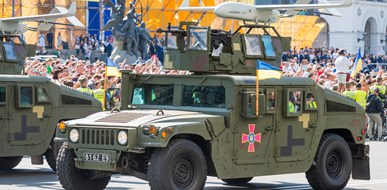Blog: Lethal autonomous weapons, war crimes, and the Convention on Conventional Weapons
Published 28 May 2019By Dr Marta Bo and Taylor Woodcock

Autonomous weapons such as unmanned aerial vehicles have been termed ‘the third revolution in warfare’ ©iStock.
Asser Institute and Graduate Institute researcher Dr Marta Bo and Taylor Woodcock argue, in a blog post written for The Global, that there is a lack of discussion on autonomous weapons and criminal responsibility for war crimes at the UN level. The blog post highlights the importance of this issue and why there should be more discussions, especially within the framework of the Convention on Conventional Weapons (CCW). The original blog post has been published on The Global, this is a re-post:
Rising alarm in the face of technological developments in weapons usually engenders diplomatic engagement and heightened attention at the highest level at the United Nations (UN). Lethal autonomous weapon systems (LAWS) are no exception. In March 2019, the Group of Governmental Experts (GGE) on LAWS, established by state parties to the Convention on Conventional Weapons (CCW), was convened for the 4th time in Geneva with an informal meeting held on 15 May to consolidate the Draft Conclusions. Delegates and experts discussed pressing issues in the context of regulating LAWS, namely the characterisation of these weapons; the human element in the use of lethal force; the challenges to international humanitarian law (IHL); and regulatory ways forward. Despite the relevance of criminal responsibility for war crimes to discussions on autonomous weapons, this subject suffers from diplomatic inertia and has not featured as one of the pressing issues extensively debated in this forum.
As an instrument of IHL, the CCW mandates the restriction or ban of the use of weapons that are considered to cause unnecessary or unjustifiable suffering or that are inherently indiscriminate. The IHL foundation of the CCW has elicited a continuing tendency to discuss the feasibility of implementing autonomy in weapons in compliance with the governing principles of the laws of armed conflict: the principles of distinction, proportionality and precautions. The preventative function of the CCW therefore sparks debate as to the compliance of LAWS with IHL ex ante. In other words, forecasting in advance the risks of non-compliance.
Rules of IHL governing the conduct of hostilities are strengthened by the international criminal law (ICL) norms on war crimes that establish international criminal responsibility for violations of the principles of distinction, proportionality and precautions in armed conflict. The Rome Statute of the International Criminal Court and the Additional Protocol I to the Geneva Conventions criminalise (explicitly or implicitly) direct attacks against civilians, indiscriminate and disproportionate attacks, and violations of the duty to take precautions in attacks. Nevertheless, at the GGE discussion of criminal consequences deriving from violations of IHL with LAWS is sparse. The European Union’s 2019 statement, with which many states were aligned, acknowledged that the international criminal law framework ‘may be relevant’ to the discussion on LAWS. Though the relevance of ICL for LAWS was raised in several instances, the actual discussion of this issue was extremely limited in 2017. This trend of a narrow dialogue around criminal responsibility for war crimes continued in 2018 (here and here) and 2019 (here, here and here).
The lack of in-depth discussion of issues concerning possible criminal consequences is unsurprising. First, the CCW framework focuses, in this case, on the ex ante ability of a weapon to be used in compliance with IHL. Criminal responsibility, on the other hand, arises ex post, after the IHL norms on means or methods of hostilities have been violated. Second, definitional uncertainty might impede the discussion of criminal responsibility. The application of ICL presupposes the existence of autonomous weapons: individual criminal responsibility enters into this debate after attacks with LAWS are carried out and crimes allegedly committed. Third, introducing ICL as an applicable legal framework to consider in the context of regulation of LAWS could hamper already convoluted and protracted negotiations.
Finally, reluctance to address individual criminal responsibility is in line with other disarmament treaties which are either silent on the matter (see Article IV of the Biological and Toxin Weapon Convention) or only oblige states to adopt ‘necessary’ or ‘appropriate measures.’ The latter include ‘penal legislation’/‘penal sanctions’ against those persons who undertake activities prohibited by the treaties (i.e. the development or use of particular weapons) in their territories or under their jurisdiction (see Article VII of the Chemical Weapon Convention; Article 5(2) Treaty on the Prohibition of Nuclear Weapons (not yet into force), Article 9 of the Convention on the Prohibition of the Use, Stockpiling, Production and Transfer of Anti-Personnel Mines and on their Destruction; Article 14 of the Protocol on Prohibitions or Restrictions on the Use of Mines, Booby-Traps and Other Devices). These treaties, despite regulating the most excessive or perilous means of warfare, fail to criminalise under international law the use of the weapons they prohibit. This is no coincidence since the history of disarmament and arms control negotiations is marked by states’ reluctance to accept constraints on their means of warfare and, to an even greater extent, to criminalise the use of prohibited weapons as war crimes.
Some words of warning are therefore offered against the exclusion of war crimes from these discussions, as well as reasons why the legal framework of ICL has bearing on the crucial objectives of the conversations surrounding LAWS.
First, ICL helps realise objectives pursued by the CCW based on respect for norms of IHL, as ICL is complementary to and serves the purposes of IHL. ICL serves as the key enforcing mechanism for IHL by ascribing individual criminal responsibility to those individuals who have committed serious breaches. ICL increases standards of precautions and deterrence, two fundamental policy objectives that are instrumental to achieving protection against the gratuitous harm in armed conflict that IHL and disarmament treaties seek to provide. Conversely, the inability to ascribe responsibility for war crimes can seriously impair compliance with IHL.
Second, discussing ICL in this debate is not an exercise in prophecy; it has real implications for technologies currently under development. Lack of agreement not only about the definition of LAWS but also about fundamental concepts such as autonomy has plagued the GGE and hindered the progress of meaningful discussions on LAWS. Definitional ambiguity compounded by state secrecy concerning the current development of LAWS translates into uncertainty about the existence of these weapons. This leads discussions away from important issues such as criminal responsibility for violations committed with such weapons. However, we should not be distracted by definitional ambiguities nor by the complexity of the technologies under discussion. The development of autonomy and automation as it currently stands present challenges to thresholds and standards for holding individuals responsible for war crimes.
Third, discussing the thresholds for the attribution of criminal responsibility could help advance the discussion of issues already on the GGE’s agenda. For example, discussions on culpability for crimes committed with LAWS and the causal nexus required so that perpetrators are personally connected to the crimes for which they are held criminally responsible are highly relevant to the definition of the human element in the use of force. Moreover, defining the contours of individual criminal responsibility could help delineate the boundaries with and the relation between individual and state responsibility, or the difference between individual criminal responsibility and the concept of responsibility for compliance with IHL, which are often conflated.
The preventative focus of the discussions on autonomous weapons, the profound divergences as to the definition and existence of these weapon systems, and the history of and politics behind disarmament treaties’ negotiations explain why the GGE has not been the forum for comprehensive discussions on ascribing criminal responsibility for war crimes committed with LAWS.
However, the CCW could and should be used as a springboard to earnestly review the implications of automation and autonomy in weapons for the ascription of criminal responsibility. Divergences among ‘military significant’ and ‘military insignificant’ states as to the adoption of a binding instrument and the archaic consensus-bound structure of the CCW (where one state could prevent the creation of new rules) are the cause of the lack of progress and stalled negotiations of the GGE on LAWS. Seen in the context of its probable failure, the GGE becomes a platform for discussion and a valuable forum for exchanges among states and between states and experts to build momentum for raising awareness about the challenges brought about by new technologies in weapons. Against this backdrop, ICL could serve the objectives of the CCW by specifying and strengthening IHL rules and standards of conduct of hostilities and delimiting acceptable standards for lethal autonomous weapons systems. Despite the ever-present political obstacles to discussions on disarmament, it is time to ensure that the platform established by the CCW is not squandered. It is time to open up the debate and to consider individual criminal responsibility for war crimes committed with autonomous weapons.
The original blog post is published on The Global.
More information:
On Wednesday 19 June T.M.C. Asser Instituut will be hosting an event entitled “Unpacking the responsibility gap(s) arising from AI applications in weapon technologies”. This symposium will address both the potential responsibility gaps in individual criminal responsibility for war crimes and State responsibility that may arise in relation to the implementation of artificial intelligence (AI) in weapon systems. For more info, click here.
